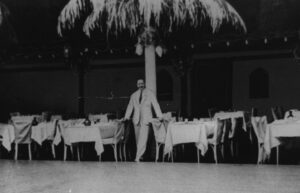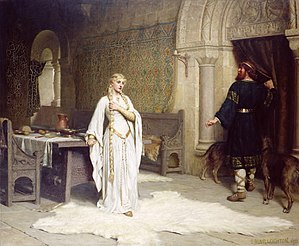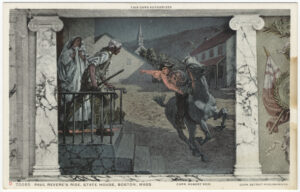
The Surprisingly Modern Santa Claus
Youngsters prepare for the annual arrival of Santa Claus in a few weeks with hopes that some last minute good behavior will tip the scales in favor to avoid placement on the Naughty List. The Santa Claus part of Christmas, as opposed to the religious side of Christmas, so much focuses on children. However, many are surprised to discover that Kris Kringle as the bearded, red suit wearing, cookie eating, stocking stuffer gift bearer for kiddies is a relatively recent phenomena. How could that be the case with the roots of Santa Claus traced back 1,700 years ago to Saint Nicholas?
To understand the evolution to the current jolly St. Nick, it is necessary to appreciate a little history of Christmas itself, the struggles of Santa Claus in keeping Christmas going, and how groups along the way incorporated Santa to achieve their purposes. Looking at this transformation may even teach us a few things this holiday season.
We can start with Saint Nicholas himself. He was a Bishop in the Church who resided in Turkey, not the North Pole. Folklore has it that at the Council of Nicea in 325 A.D., Nicholas’ disagreement with religious brethren resulted in him suffering a broken nose during a fight. The remains of Saint Nicholas confirmed the broken nose, but the underlying tale of fisticuffs cannot be historically verified.
Despite this reputation, Nicholas possessed a soft side when it came to children. He gave away his wealth to those in need and protected children. For instance, Nicholas provided three bags of gold to a poor father of three girls to be used as dowry. Absent a dowry, the girls were headed toward careers as “professional” women of the evening. Further protecting children, while at an inn, Nicholas discovered three dead children fermenting in brine barrels. Saint Nicholas resurrected the pickled children and punished the inn keeper.
These deeds to protect children and a view of him as a common, tough fighter resulted in his tremendous popularity through the Middle Ages. Saint Nicohlas became so celebrated that his feast day, December 6, would be celebrated by giving gifts to children (gifts to children sounds familiar).
On a separate track and not associated with Saint Nicholas, in the 400s, Pope Julius I decreed December 25 as the Feast of the Nativity to recognize the birth of Jesus. But why December 25? As the Catholic Church has done in other instances, Pope Julius I appears to have hijacked a pagan ritual. The Roman feast of Saturnalia culminated in late December with much wine and food to celebrate the harvest. At the winter solstice, Romans also began the feast of Juvenilia which honored Roman children (focusing on children at a holiday sounds familiar). Finally, Romans already celebrated December 25 as the birthday of Mirtha, the god of unconquerable sun (December 25 as a birthday sounds familiar).
December 25 also fit neatly with other cultures for Pope Julius I. In Germany, the winter solstice honored the pagan god Oden. Oden, apparently not a particularly cordial god, would make night time flights observing his subjects to determine who would perish and who would prosper (nocturnal flights, evaluating who has been naughty or nice sounds familiar).
In Scandinavia, the Norse celebrated the feast of Yule, beginning on December 21. Yule recognized the return of the sun and longer days. Large logs would be set ablaze with the Yule festival lasting as long as the fire. These logs would burn up to 12 days (12 days of celebration sounds familiar).
Church leaders embraced this December 25 Christmas and coopted traditional winter solstice customs and festivals as part of Christmas. By the Eighth Century, Christmas had spread across Europe and North Africa with confirmation of such celebrations in such far away lands as England, Scandinavia and Egypt. But the combination of Christmas with pagan rituals appears to have resulted in unintended consequences.
By the Middle Ages in Europe, celebrations for Christmas included attending church in the morning followed by all day drinking and rowdy activities. Someone would be declared “lord of misrule” to lead others to the houses of the rich demanding more drink and food. But wild and drunken parties could not be tolerated by the Puritans who would then come to power.
The Puritan Reformation in the 1500s and 1600s ushered in a declaration of war on Catholic saints and holidays such as Christmas. The Pilgrims brought this Puritan set of beliefs to the New World. In fact, between 1659 to 1681, the celebration of Christmas was outlawed in Boston with a five shilling fine for anyone exhibiting the Christmas spirit. However, beyond Puritan control, Christmas lived on.
At this time, the Dutch honored Saint Nicholas or “Sinterklaas” during the Christmas season. The Dutch portrayed Sinterklaas in a red bishop’s miter and snowy white beard (red hat, white beard, named Sinterklaas sounds familiar). When the Dutch migrated to New York, they brought Sinterklaas with them. Christmas again flourished in America, at least until the early 1800s. However, Christmas festivities still reflected more of an adult, carnival drink fest than the celebration focusing on children, family, religion and peace.
In the early 1800s, the Saint Nicholas Society in New York discovered the ideal front man to transform Christmas celebrations: St. Nick himself who was known and beloved for being so kind to children. This Society sought to make Christmas a family event through St. Nicholas. They received prompt support from writers and artists.
Enter well-known author Washington Irving. In 1819, Irving published “The Sketchbook of Geoffrey Crayon, gent”. This series of short stories reflected a peaceful Christmas scene of an English country squire hosting society’s well-to-do together with the less fortunate. Irving presented the combination of all from society enjoying Christmas together as some ancient custom, despite being a complete fictional account. The American audience began following these more peaceful “ancient” customs.
In 1821, an anonymous poem, “The Children’s Friend”, circulated featuring “Santeclaus”. Santeclaus traveled by sleigh pulled by reindeer with rewards for children. Clark Moore followed with his poem in 1822 entitled “An Account of a Visit from St. Nicholas”. This poem is only slightly better recognized by its opening line: “Twas the night before Christmas . . .” with a complete description of Santa Claus included.
Other contemporary literary works more firmly established Christmas as the charitable, gift-giving season offering well wishes. Charles Dickens published “A Christmas Carol”. But it was not until 1881 that the current depiction of Santa Claus arose. Cartoonist Thomas Nast immortalized Santa Claus as the jolly elf with white beard, red suit and sack of toys in his illustration of Moore’s classic poem “Twas the Night Before Christmas”. Santa Claus as the marketing and advertising dream was then born. Santa never looked back.
Part of how we understand and appreciate Santa Claus is a blind acceptance that he has been around a long, long time. He was there for us as children, our parents and grandparents when they were children, and countless prior generations of children before them. Christmas tales reinforce this idea of the timelessness of Santa Claus. However, everything is not always as it appears. Santa Claus confronted real struggles to get where he is today. Thanks to the Scandinavians, Sinterklaas appears to have bridged the gap between the feast day of Saint Nicholas and Christmas day. More importantly, St. Nick survived the Puritanical purge of saints during the Reformation. Despite being outlawed in Boston, Kris Kringle re-emerged in New York and elsewhere. Only with literary assistance in the 1800s did Santa Claus become as we know today.
We take, as we must, the story of Santa Claus at face value. Nonetheless, the back story illustrates a figure forced to address numerous challenges and one who changed to meet the circumstances of the day. The evolution of Santa should remind us that those with whom we deal probably have their own back story with unique sets of challenges about which we have no idea. Perhaps we can show greater sympathy and empathy this holiday season assuming that others may also have had difficult obstacles to overcome as did St. Nick.
I could go on about how the story of Santa Claus provides lessons for mediation such as accepting changed circumstances, having to dig deeper into backgrounds of storylines, and how difficult it would be to sell fanciful stories to triers of fact. Instead, this holiday season, I simply wish peace and hope you enjoy the spirit of the very modern Santa Claus.




